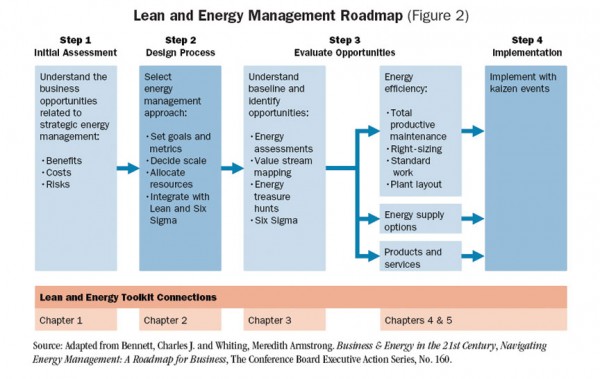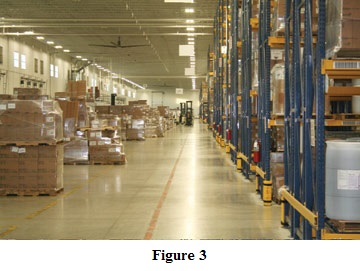Manufacturers Are Discovering That Producing Smarter Means Cutting Energy
It now seems like a thousand years ago, but before the wave of economic bad news, many managers and executives had been weighed down by out of control energy prices, and with a fear that the world was reaching peak oil production and things would get even tougher.
Now, businesses have other things on their minds. But the good news is that as companies are wringing more out of their assets, in the process they are cutting back on energy consumption. What a bargain.
Time Magazine, at the end of 2008, noticed this trend, explained in an article “America’s Untapped Energy Source: Boosting Efficiency.” As they point out, improving efficiency will not alone solve our ongoing energy problem, but it is “a renewable energy source that is perfectly clean, remarkably cheap, surprisingly abundant and immediately available.” As happens often, this kind of energy source is a by-product of something we are doing right now – finding more ways to produce more, but in less time, and with fewer resources.
Industry is tracking their carbon footprint for good reason. In 2004, the National Association of Manufacturers related in their report “Efficiency and Innovation in U.S. Manufacturing Use” that industry can cut their energy use by 20%. This translated into $19 billon in savings in 2004. About 30% of these savings can be achieved without capital investment, using only procedure and behavioral changes.
These changes can be brought about with the use of tactical tools such as Lean Management, often using Six Sigma. With Lean/Six Sigma, the target is waste, which ultimately sets energy use in its sights.
One reason why Six Sigma is used to make operations more efficient is that it is a great detective tool. Robert Johnson is the Quality Assurance Manager with the Tyco Fire Suppression and Building Products plant in Lubbock, TX, where they manufacture millions of fire sprinklers annually. He is also immediate past chair of the American Society for Quality Lean Enterprise Division.
One such detective story at Tyco was the mystery of the faulty fire sprinkler seal. Setting in motion a black belt Six Sigma project, the Tyco team used root cause and failure mode analyses to look at hundreds of leakers and track down the elusive problem.
 Their investigation turned up several rather simple but not readily apparent problems. The first problem was that the cardboard dunnage which carries valves through manufacturing, was leaving fibers on the valve seat area. The simple solution – Tyco switched to plastic dunnage. (Figure 1)
Their investigation turned up several rather simple but not readily apparent problems. The first problem was that the cardboard dunnage which carries valves through manufacturing, was leaving fibers on the valve seat area. The simple solution – Tyco switched to plastic dunnage. (Figure 1)
Controlling the flow of work can be another strategy that reduces both production costs and energy bills. Chad Vincent is ASQ Lean Enterprise Division for Social Responsibility Liaison, and has the opportunity to look into a number of operations. “The traditional approach in a lot of plants,” he observes, “is that in driving down the inventory count at the end of the month, there can be a lot of wasted effort. What happens is there is a big push to use up the entire inventory. While that may keep the accountants happy, there are some real energy savings that can be missed.”
Vincent points out there are peaks and valleys in the action along the production line using that approach. He recommends applying line balancing with the help of Six Sigma to shave these outcroppings, even eliminating an extra shift. Machinery can be right-sized more precisely, equipment can be on only when needed and HVAC systems can be operating fewer hours.
“That,” concludes Vincent, “translates into energy savings.”
“Six Sigma has been a great help to us,” says Bill Bailey, principal consultant in DuPont’s Energy Engineering Group in Charlotte, NC. This internationally renowned sciences and services company has been using Six Sigma, Lean Management and other improvement tools for the past decade and credits these approaches with reducing energy use by 7% while growing production more than 40%. Bailey is tasked with leading the company’s efforts to accelerate improvement in energy efficiency.
“Certainly we have had success in improving energy use through the years, but most people at DuPont would agree that we have been able to make more improvements faster and ensure we keep these changes active using these tools.”
Bailey goes on to explain, “In the energy realm, most defects are invisible and you really need data to verify that you are using more energy than you should be.”
He credits the interaction of energy champions at the 100 largest plants with broad leveraging of improvement opportunities. “At the moment,” says Bailey, “we are tracking over 600 defect-elimination projects.” One of their plants discovered a defect in the design of a large combustion system. Annual energy savings were sufficient to produce a 60% internal rate of return on the total investment.
DuPont also recognized the need to silently monitor unit operations and alert personnel when equipment performance had drifted from optimum, leading to the development of an Excel-based tool called the Energy SMARTBoard. This program receives live and historical data from a plant’s process data historian and, based on rules and heuristics, determines when energy-saving measures are not working as well as possible.
The SMARTboard calculates the amount of excess energy required for current operation and translates that defect into an annual savings stake. Operators can understand the value of corrective action.
The SMARTBoard helps operators troubleshoot poor performance and return unit operations to optimum. “The tool,” Bailey points out, “has enabled one site to maintain the savings level of a dozen Six Sigma projects, avoiding annual energy costs of over $1MM.”
Long regarded as an enforcement agency, the U.S. Environmental Protection Agency through its National Center for Environmental Innovation (NCEI) has been working with companies to develop better ways to process and manufacture that are coincidentally cutting down on emissions and saving energy. This is certainly the case with Lean/Six Sigma.
“Lean usually helps the environment without really intending to,” observes Mitch Kidwell, senior staff person with the center. “It means less material resources are used per unit, and produced energy is used more efficiently.”
Often environmental costs and impacts are regarded as overhead. In working with companies, NCEI seeks to bring the production side and the environmental side of the company together to recognize that they are achieving manufacturing and energy benefits simultaneously.
“Where Six Sigma comes in is being able to focus on the variability of a process,” says Kidwell. “It’s a wonderful tool for not only removing big spikes in plant energy use throughout the day, but also balancing their consumption, while also detecting the cause of production rejects.”
The companies that have used Lean are eager to share, and the EPA has compiled their stories plus tips on how to implement lean/Six Sigma into their “Lean and Environment Toolkit.”
(Figure 2)
 To consolidate their growing business into one facility, JohnsonDiversey recently opened a massive 550,000 sq ft distribution center (DC) in Sturtevant, WI, to handle their growing world-wide commercial cleaning business. The building’s sustainable design earned a LEED-NC Gold (Leadership in Energy and Environmental Design for new construction).
To consolidate their growing business into one facility, JohnsonDiversey recently opened a massive 550,000 sq ft distribution center (DC) in Sturtevant, WI, to handle their growing world-wide commercial cleaning business. The building’s sustainable design earned a LEED-NC Gold (Leadership in Energy and Environmental Design for new construction).
This is one of the largest industrial buildings to garner the gold. The building features a state-of-the-art ventilation system, a water system that has reduced usage by 51% and a foundation made of totally recycled material.
But JohnsonDiversey isn’t stopping there. They are currently working on a LEED-EB certification for existing buildings. This is an all-encompassing process with JohnsonDiversey bringing their vendors into the effort.
In their operations, forklifts are the heaviest energy users. There are 75 Crown forklifts, and according to JohnsonDiversey’s regional warehouse manager Bruce Maple, “Crown has gotten on board with our green program.” (Figure 3)
 Crown has taken the initiative to suggest improvements, developing a high frequency system to detect when the battery is fully charged to then power the charger off. In addition, the charger process has been arranged to process the batteries in stages to shut down completely during certain hours of the day. Management has also configured the forklifts travel patterns to minimize travel, time and energy.
Crown has taken the initiative to suggest improvements, developing a high frequency system to detect when the battery is fully charged to then power the charger off. In addition, the charger process has been arranged to process the batteries in stages to shut down completely during certain hours of the day. Management has also configured the forklifts travel patterns to minimize travel, time and energy.
Anthony Manos, a principal partner with the Chicago consulting firm Profero, has worked with over five dozen companies in implementing Lean Management and setting up preventative/predictive maintenance programs. He advocates a program of total productive maintenance to ensure operations are on track; this is a lean concept and a combination of planned maintenance procedures and predictive maintenance. Both enable operations to stay ahead of developing glitches. “The problem for many companies, and I’m talking about very large companies,” says Manos, “is that many are just involved with reactive maintenance and have trouble making the leap to predictive.”
This takes some discipline. Manos discusses using Six Sigma and Kaizen events to measure the deviations in an operation to determine where the losses are in performance and analyzing them using a Pareto chart, ranking deviations to determine which ones to attack first.
By Keith Schmitz
Originally Published: Sept. 1, 2009

